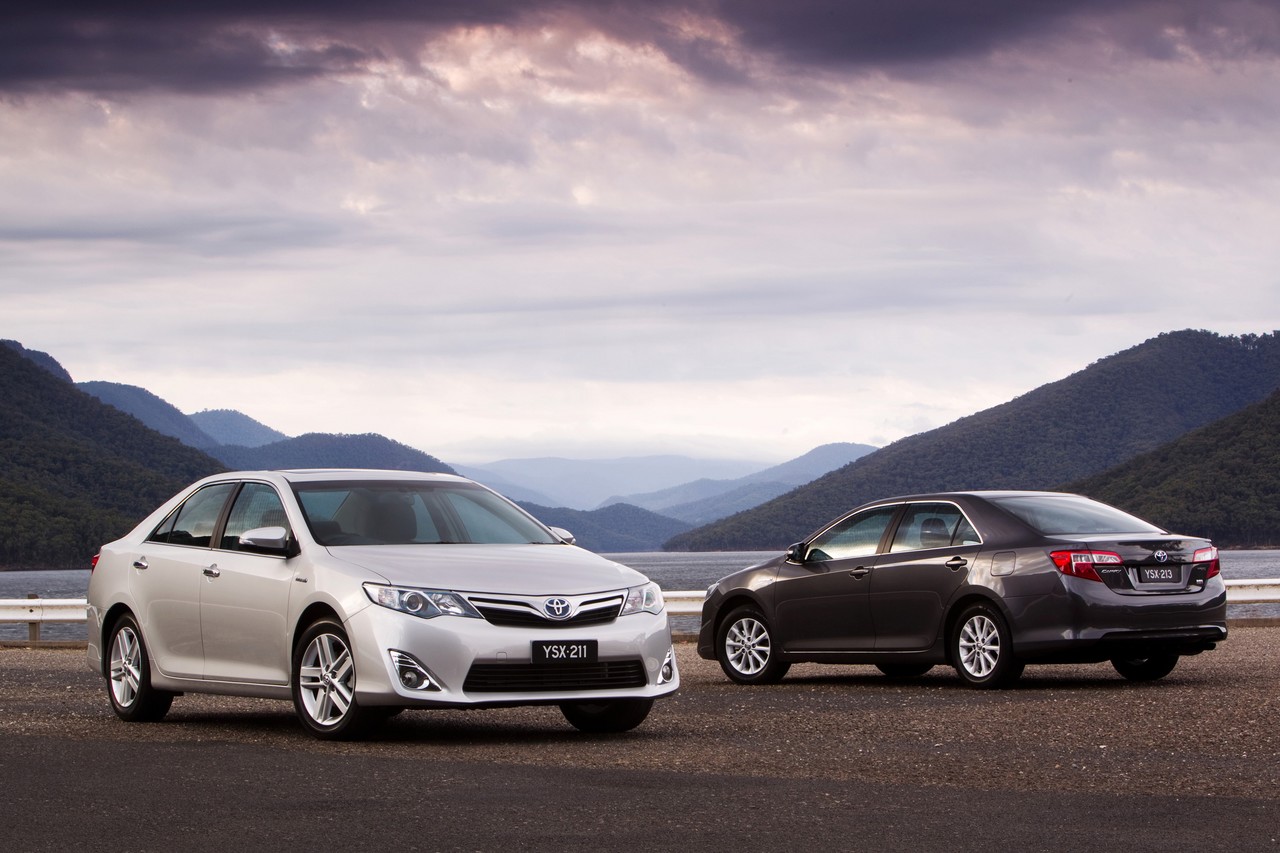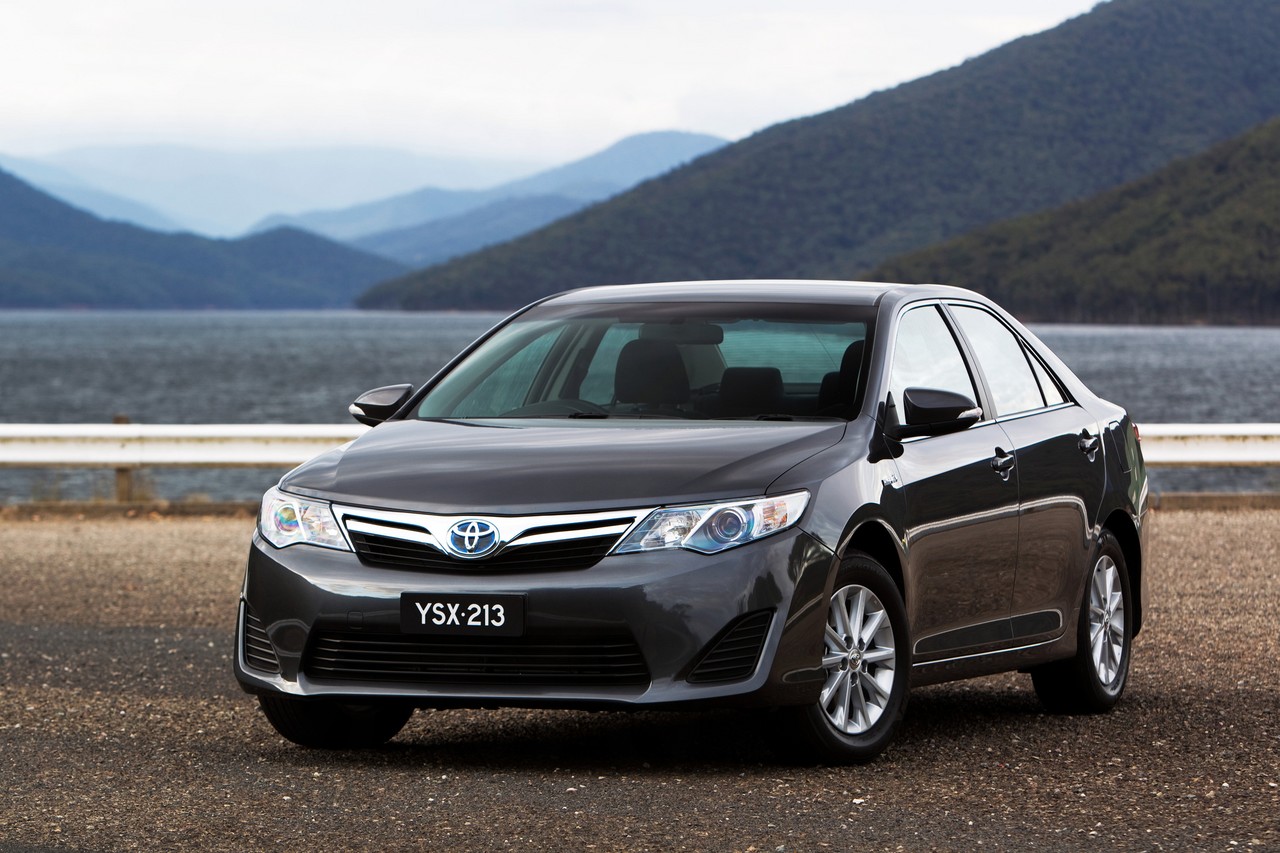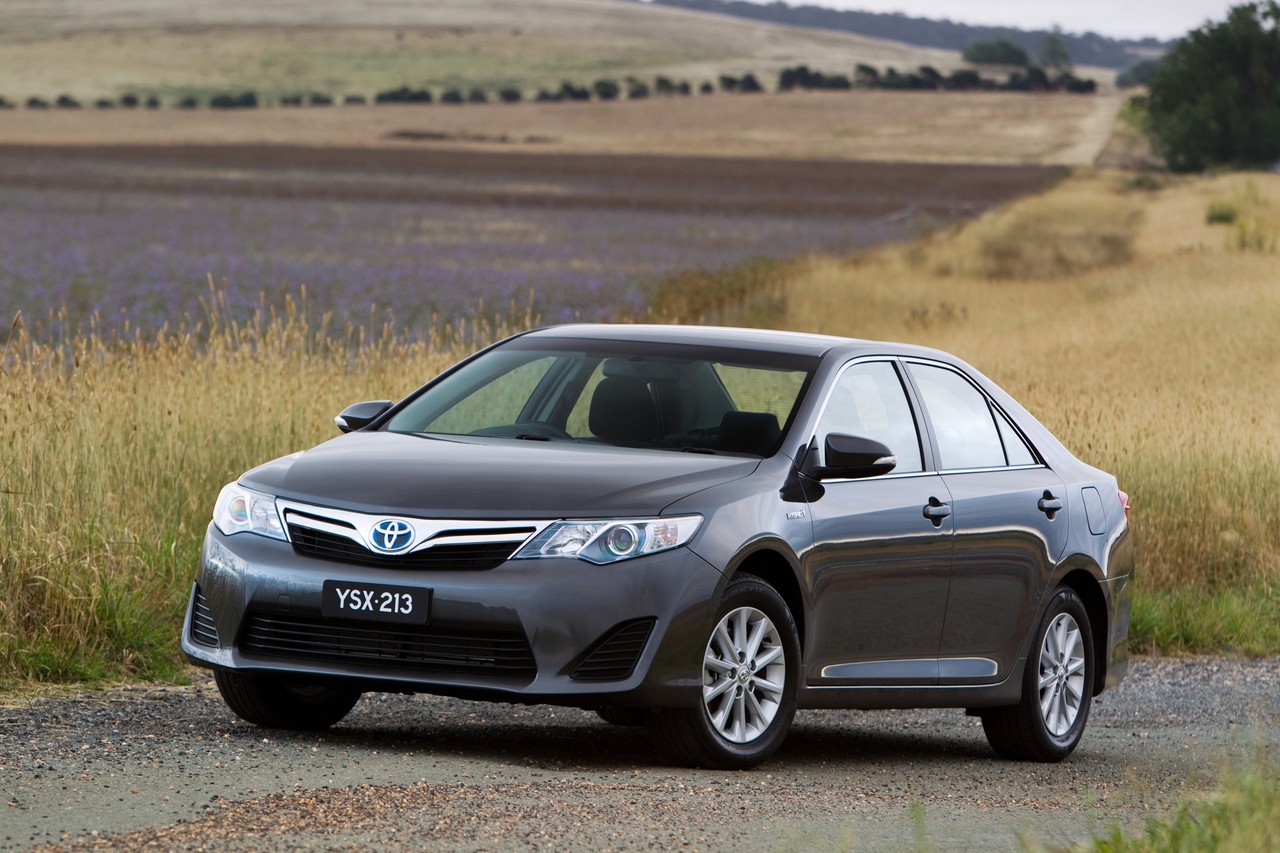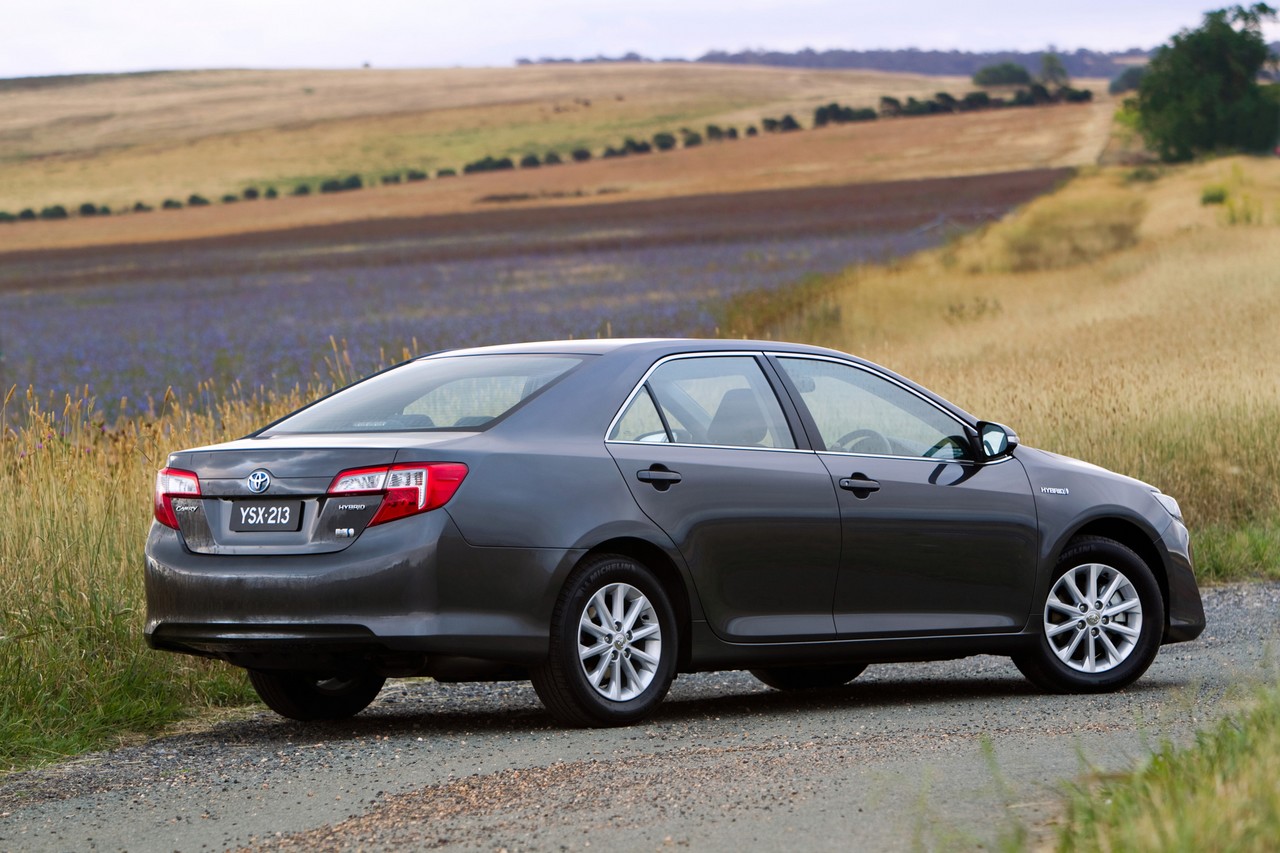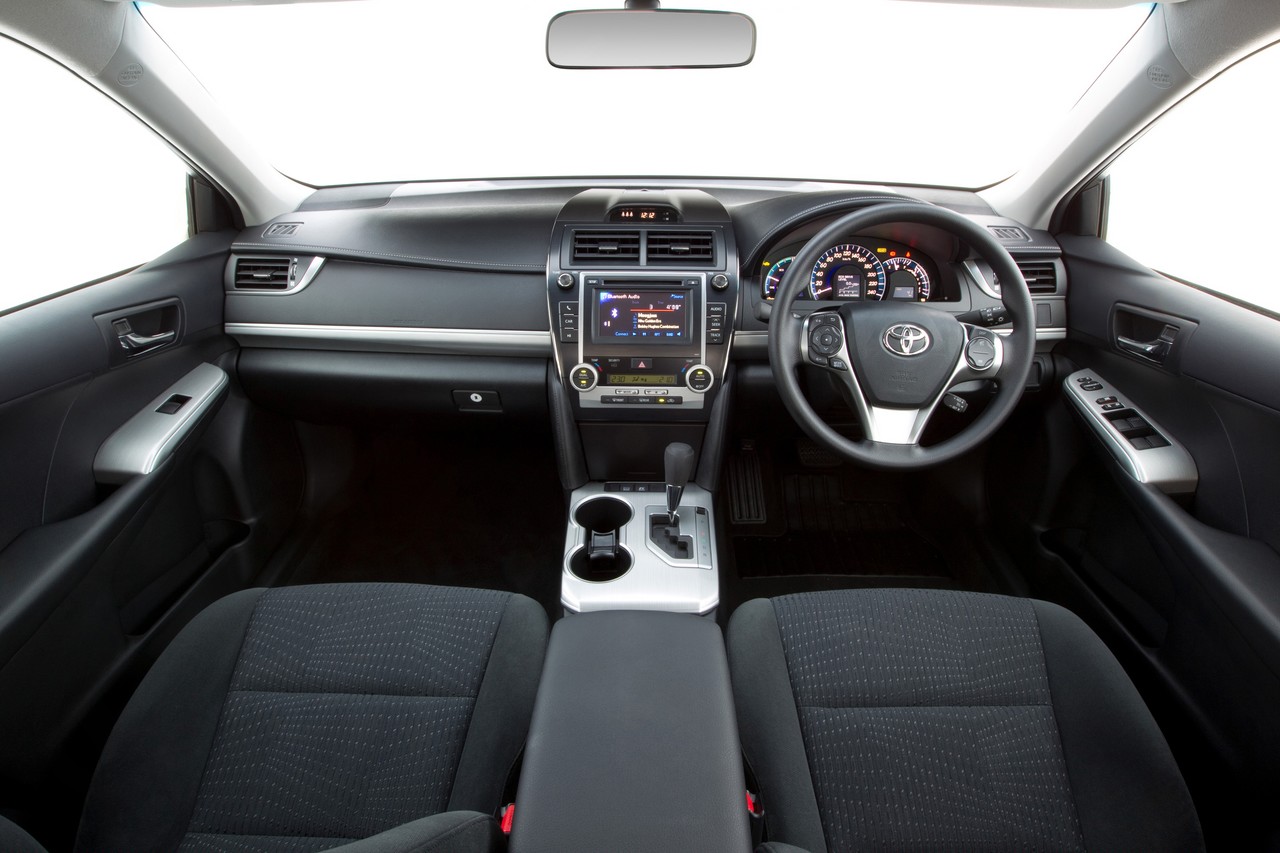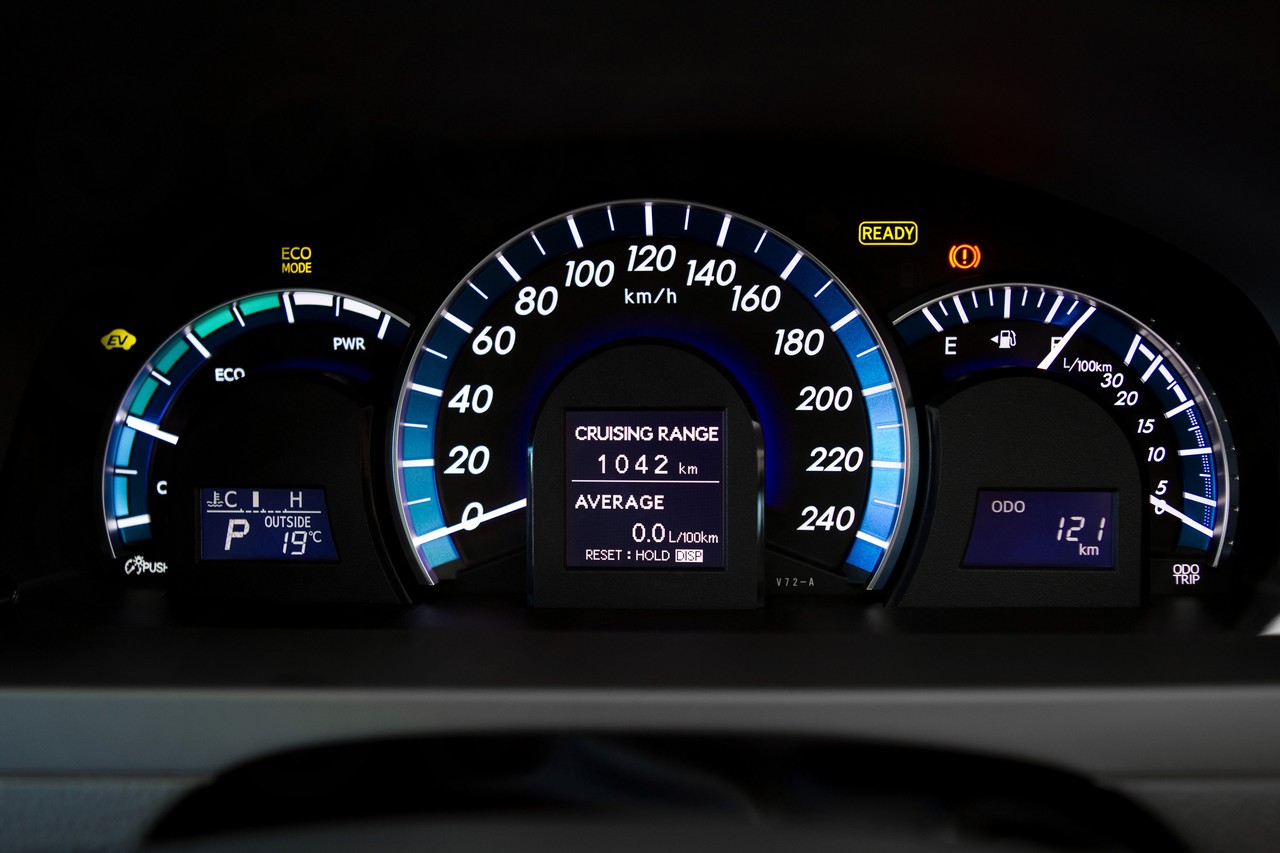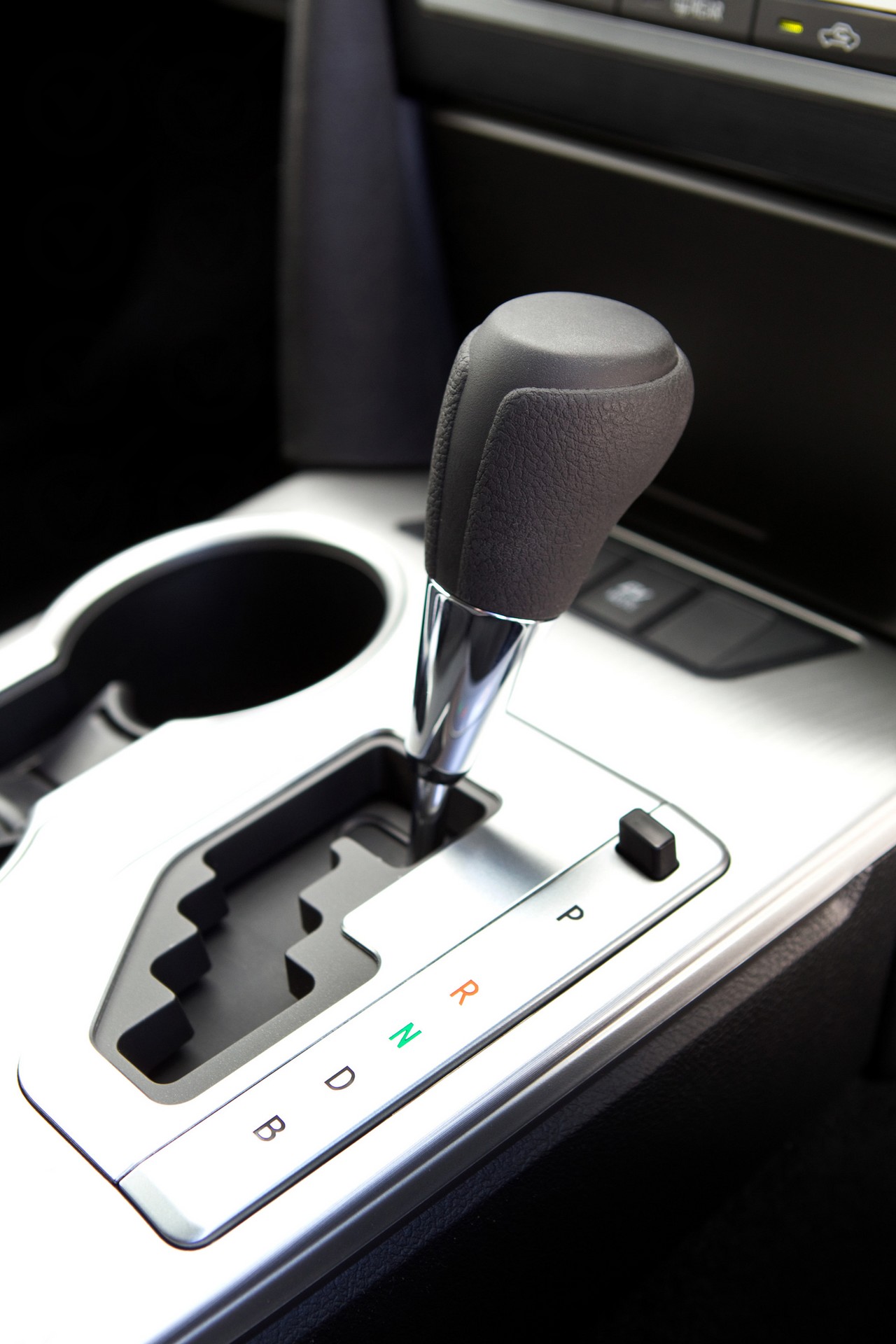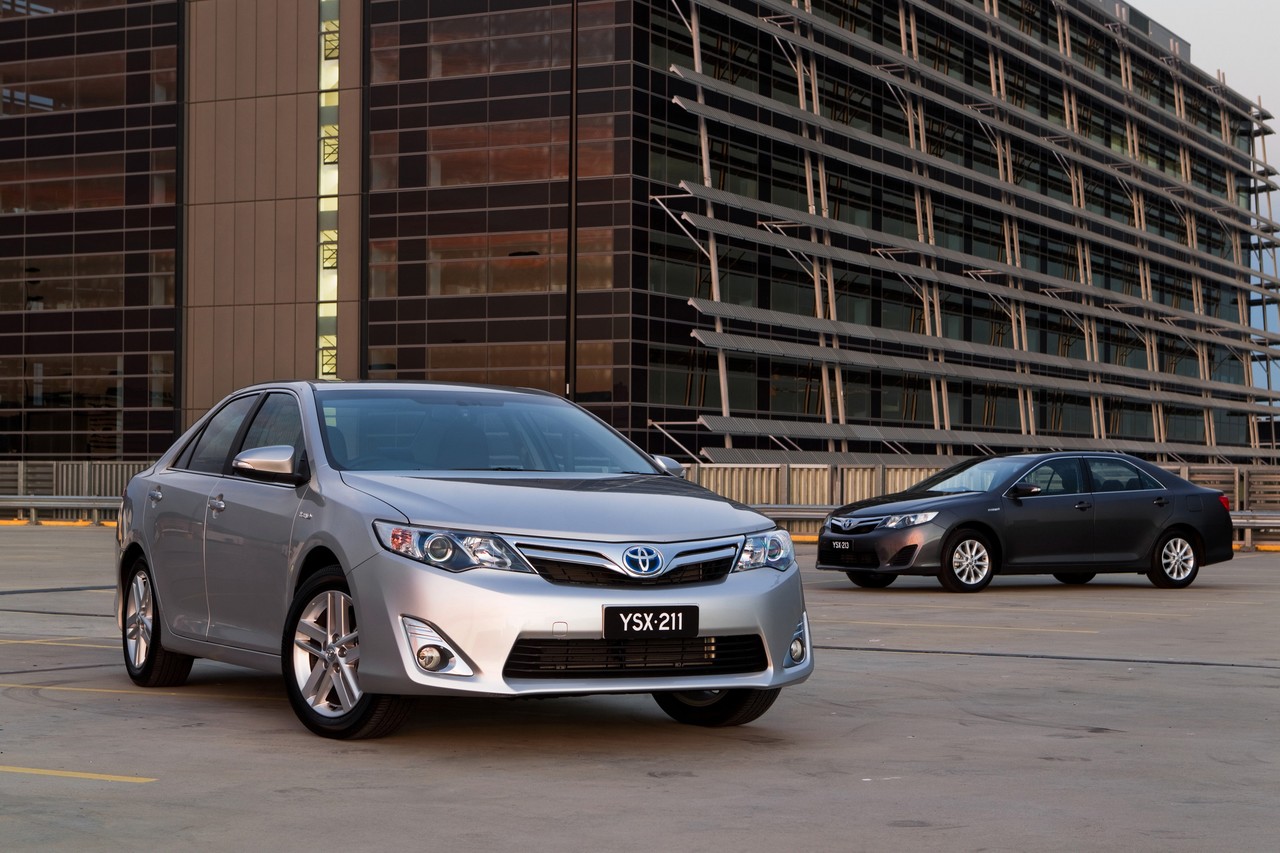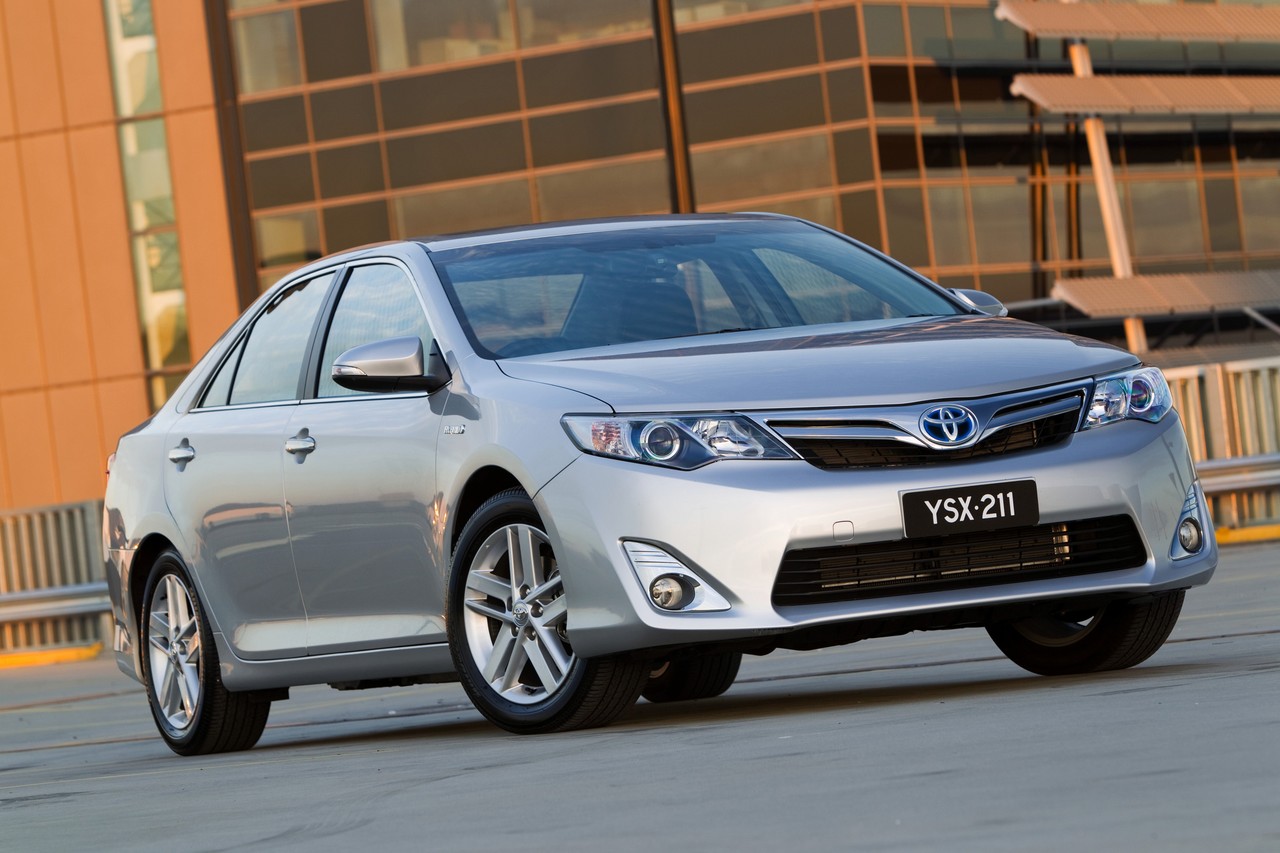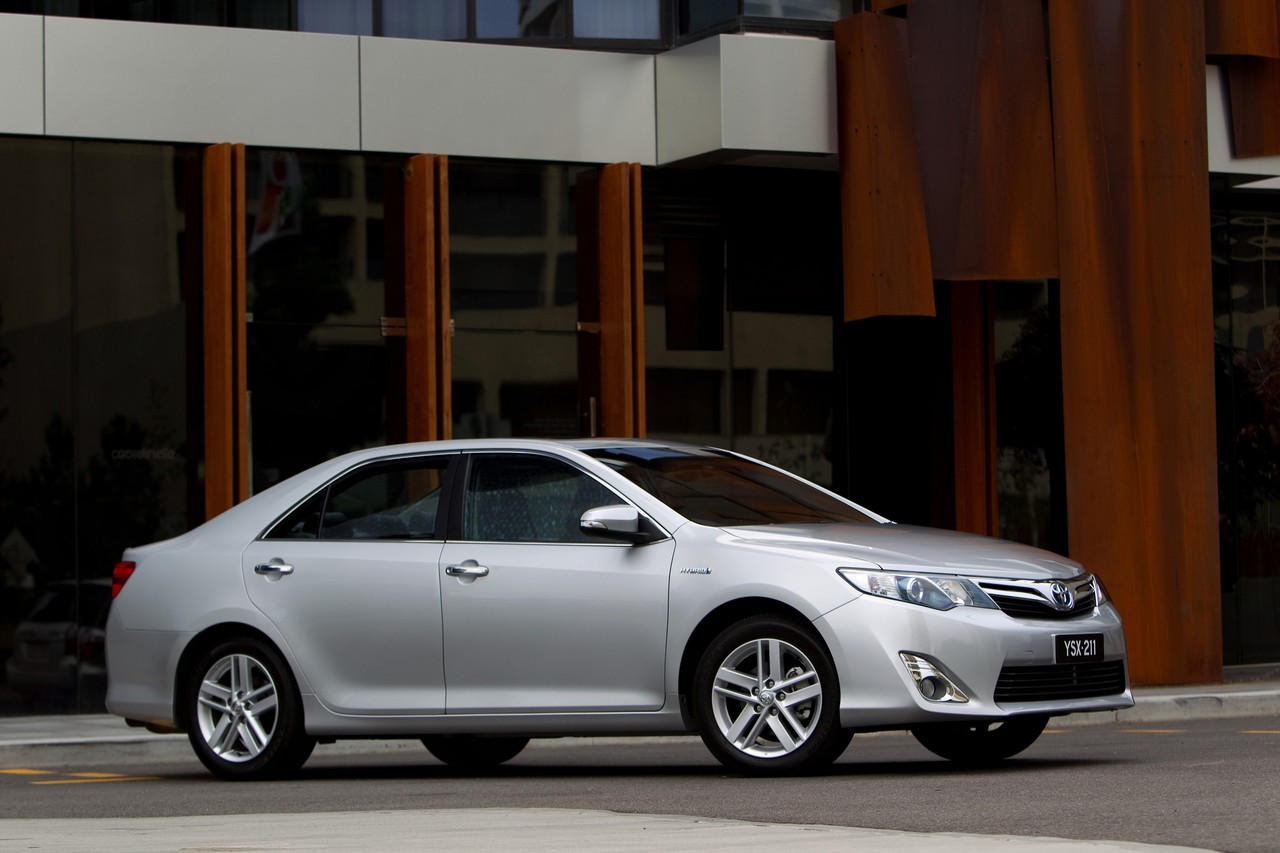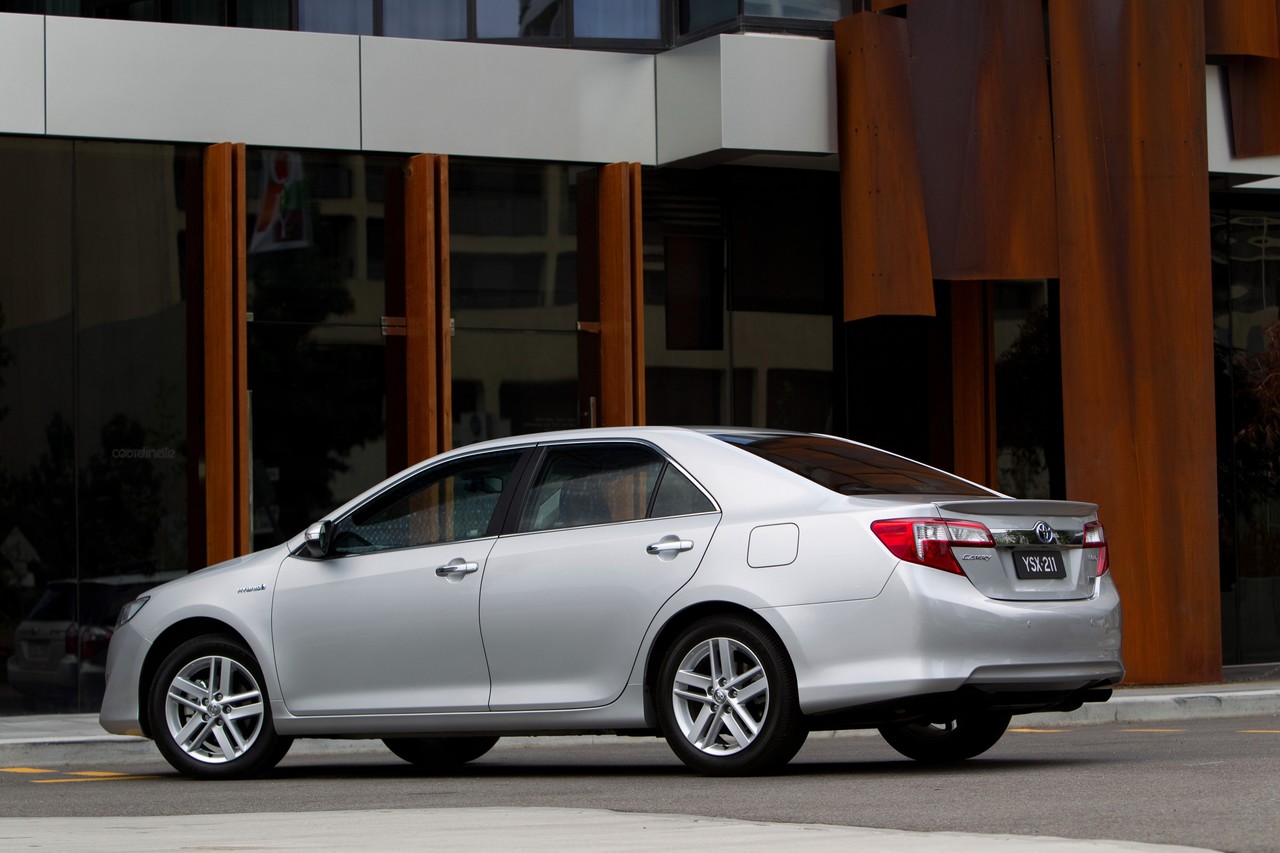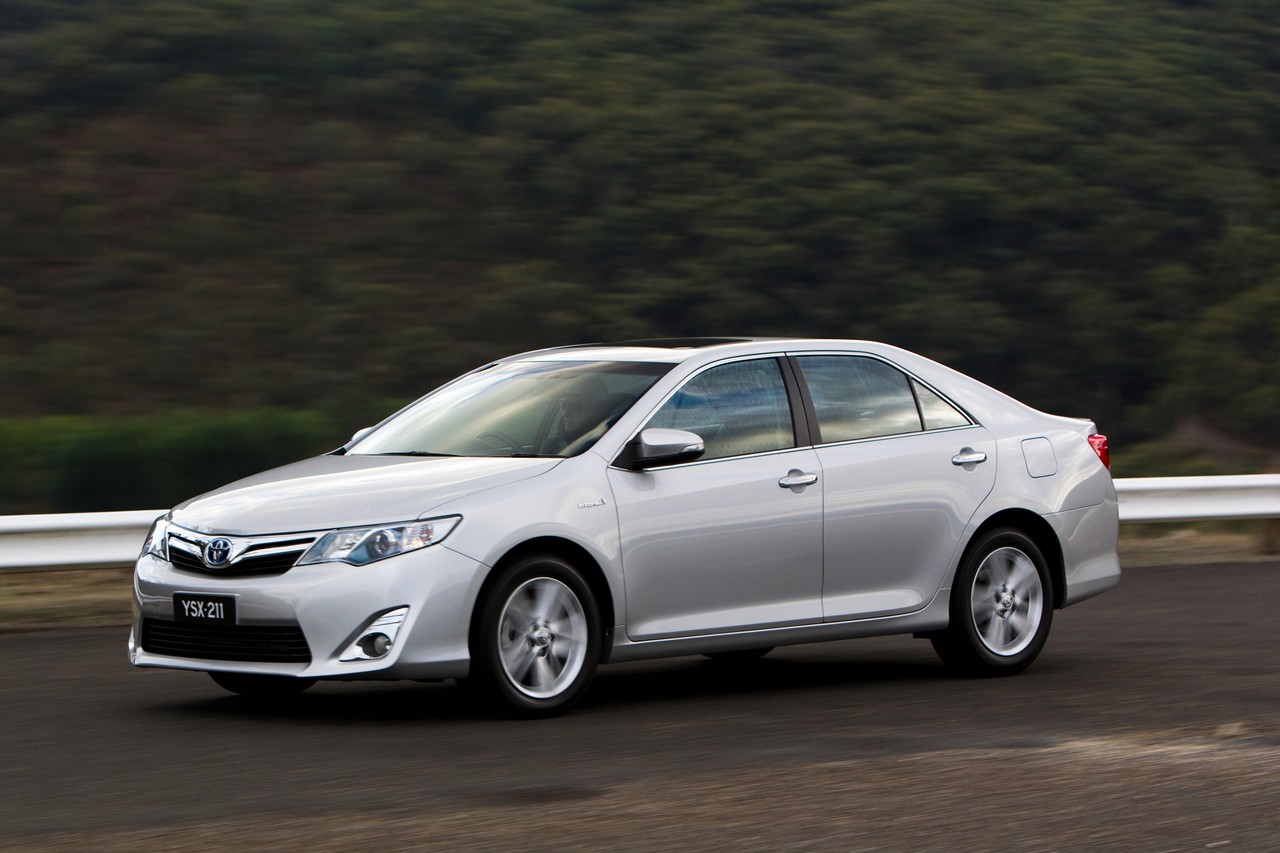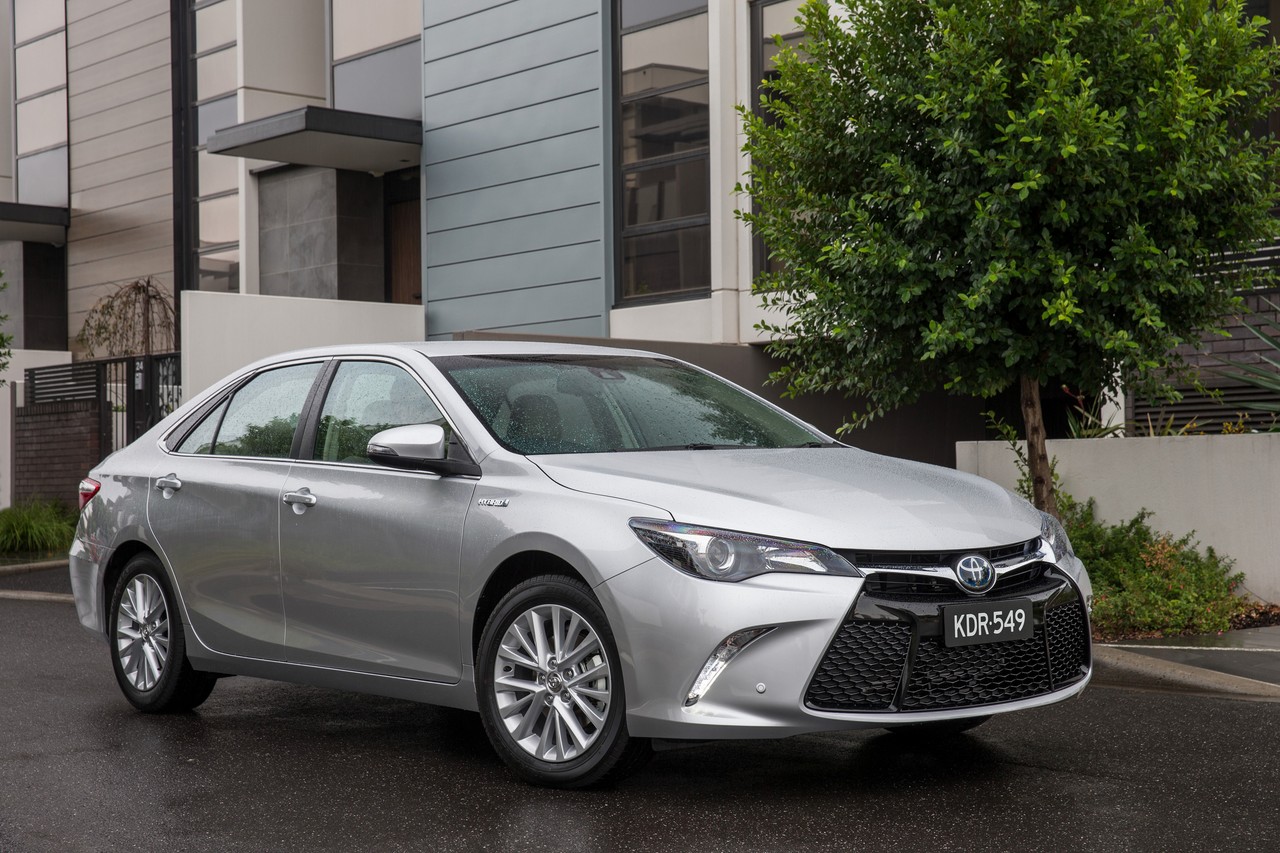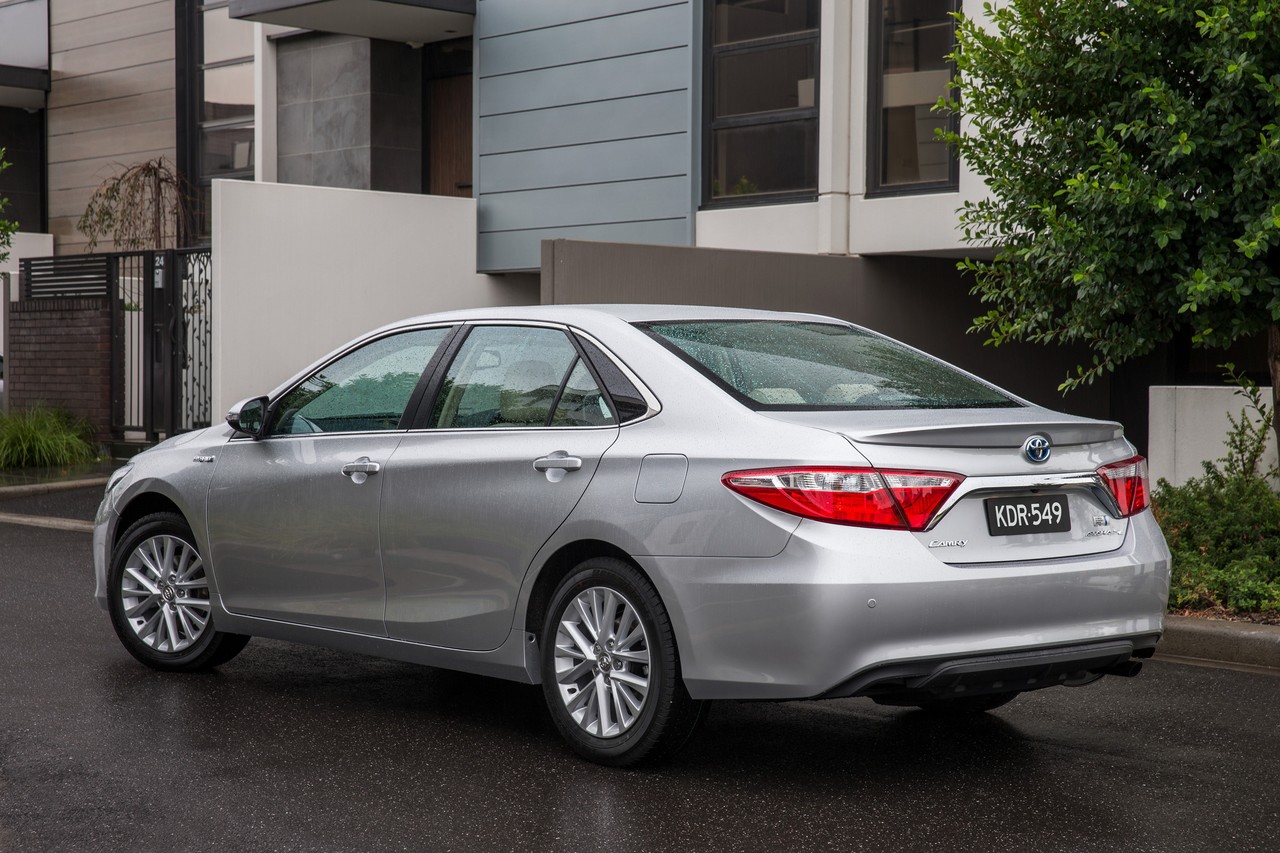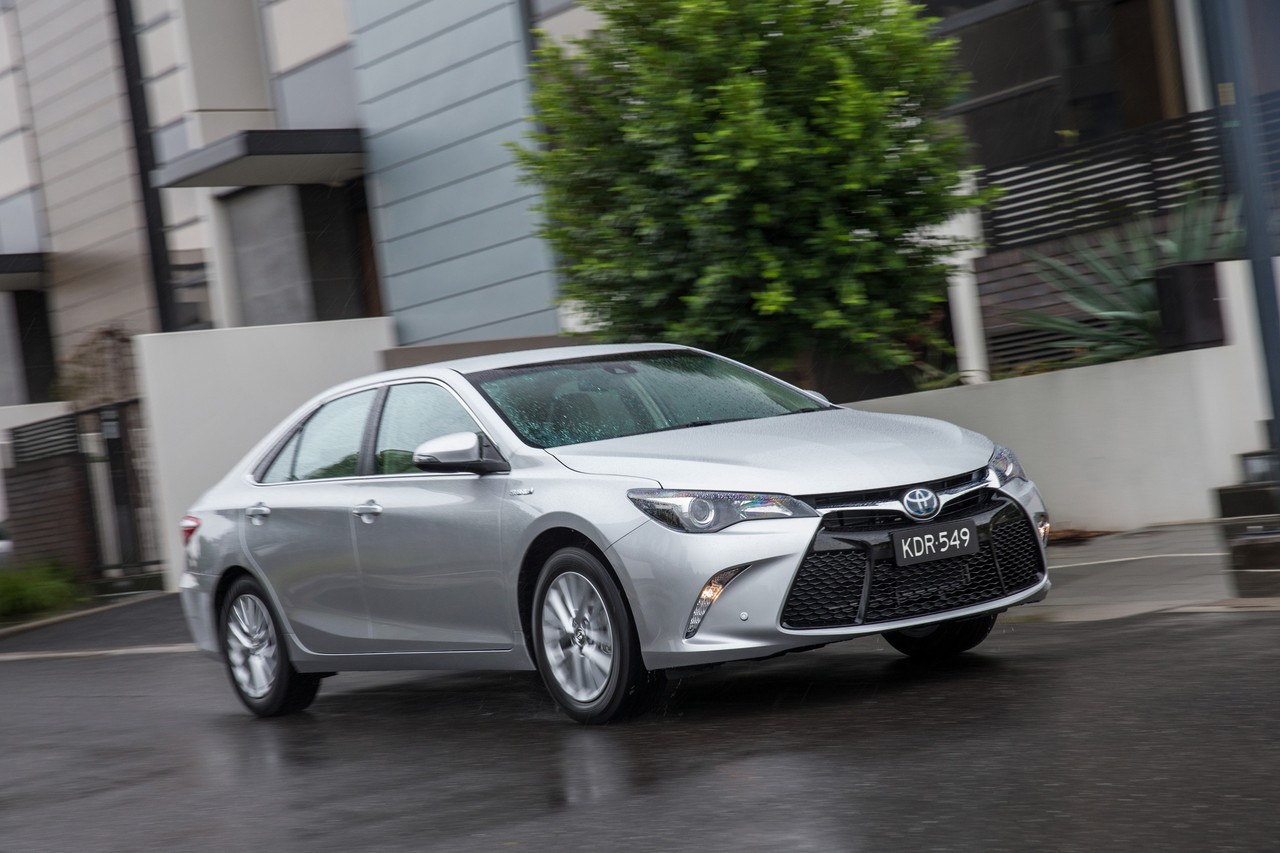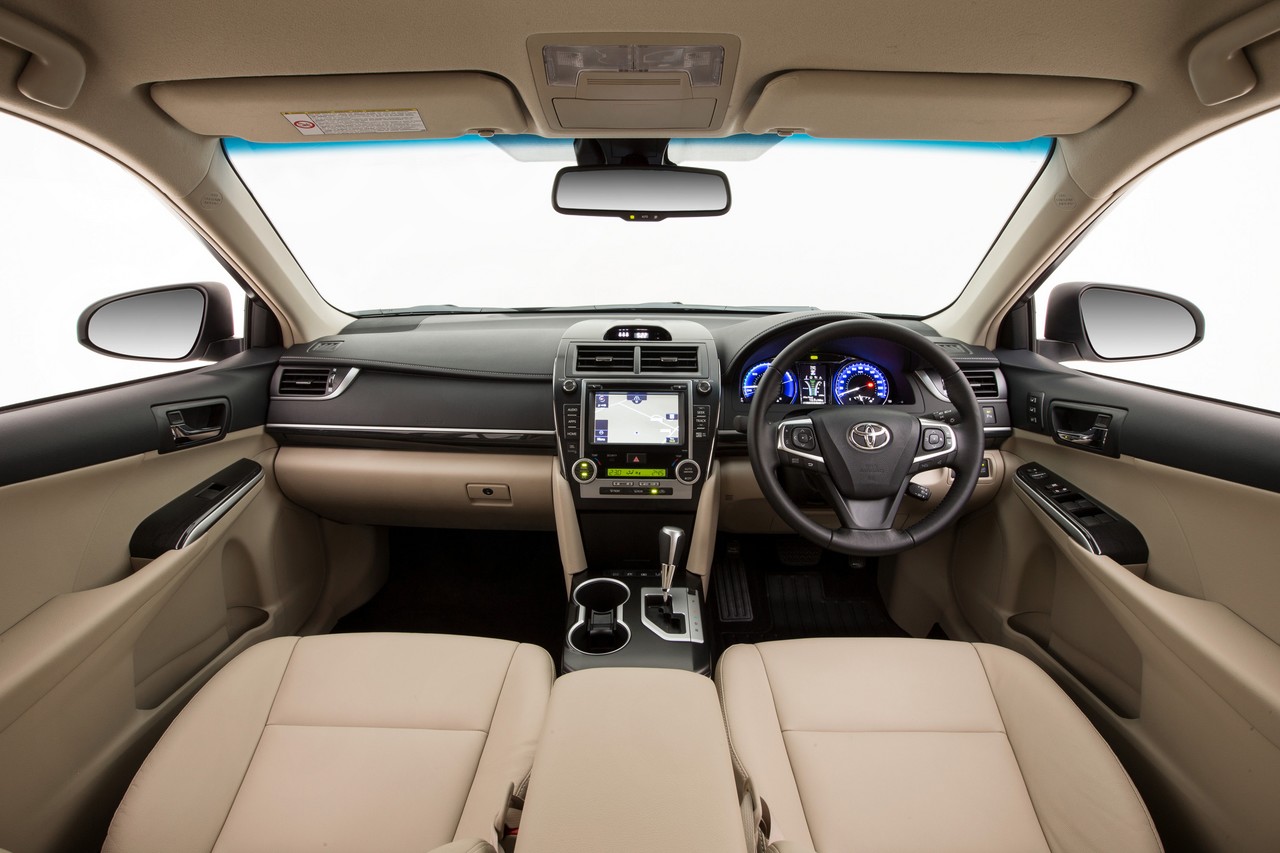
- Responsive and economical hybrid powertrain
- Impressively quiet cabin
- Comfortable front seats
- Spacious interior
- Comfortable ride
- Light steering is vague around centre position
- Overly sensitive brake pedal lacks progressive feel
- Mismatched interior plastics
- Nickel metal hydride batteries reduce boot space
Review: Toyota XV50.I Camry Hybrid (2012-15)
Overview
Released in March 2012, the Toyota XV50 Series I (XV50.I) Camry Hybrid was a front-wheel drive sedan. Manufactured in Altona, Victoria, the Camry Hybrid had a ‘Hybrid Synergy Drive’ powertrain which consisted of:
- a 2.5-litre 2AR-FXE four-cylinder Atkinson cycle petrol engine;
- two 650-volt AC motor/generators;
- a step-up converter and inverter to draw current from the 244.8 volt DC nickel metal hydride battery; and,
- an electronically-controlled continuously variable transmission (E-CVT).
Of the two motor/generators, one acted primarily as a generator while the other operated primarily as the electric drive motor but could also function as a generator during regenerative braking. Furthermore, the compound planetary gear seat consisted of two sets of planetary gears. While the first planetary gear set acted as a power-split device (dividing petrol engine between the generator and the front axle), the second worked as a reduction gear for the electric drive motor.
Drive modes and fuel consumption
To minimise fuel consumption, the XV50 Camry Hybrid had:
- An ‘ECO’ drive mode which adjusted throttle response and air-conditioning output for maximum fuel economy;
- An ‘Electric Vehicle’ (EV) mode in which it could operate solely on its electric motor for up to 2 kilometres at speeds below 45 km/h; and,
- A regenerative braking function whereby a generator converted the kinetic energy of the wheels when braking to an electric current to charge the battery pack.
Over the combined ADR 81/02 test cycle, the Camry Hybrid models achieved fuel consumption of 5.2 litres per 100 kilometres.
Comparison with XV50 Camry
Compared to the standard XV50 Camry , the Camry Hybrid had additional sound-absorbing materials in the engine compartment and an acoustic windscreen (i.e. with noise-absorbing film between the two layers of glass). For the XV50 Camry Hybrid, the DC/DC converter was relocated to the engine bay to increase boot space to 421 litres, though this was 94 litres less than the standard XV50 Camry’s 515 litre boot.
Visually, the hybrid Camry variants could be identified by their radiator grilles which had a chrome upper section, ‘hybrid blue’ Toyota badges and blue-accented headlight extensions. Inside, the hybrid variants had additional brushed silver inserts.
Dimensions
Compared to the XV40 Camry Hybrid , the XV50 Camry Hybrid was the same length (at 4815 mm), 5 mm wider (1825 mm), 10 mm lower (1470 mm) and had the same length wheelbase (2775 mm). Kerb weight for the XV50 Camry Hybrid was reduced by 35 kg to 1610 kg, while the XV50 Camry Hybrid also had an unbraked towing capacity of 300 kg.
Steering and suspension
The XV50 Camry Hybrid had electric power-assisted steering, coil-over suspension with MacPherson struts front and rear, with L-shaped lower arms at the front and dual transverse links at the rear. For Australia, the Camry Hybrid had locally-developed steering and suspension calibrations.
| Engine | Trans. | Peak power | Peak torque | |
|---|---|---|---|---|
| Camry H, Camry HL |
2.5-litre petrol I4 (2AR-FXE) | CVT | 118 kW at 5700 rpm | 213 Nm at 4500 rpm |
| 650 volt electric motor | 105 kW | 270 Nm | ||
| Combined | 151 kW | N/A | ||
Safety equipment
Standard safety equipment for the Camry Hybrid included dual front airbags, a driver’s knee airbag, front side airbags, full-length curtain airbags, ABS, electronic brake force distribution, brake assist, electronic stability control, traction control and front seatbelts with pretensioners and load limiters.
The Camry Hybrid HL was further equipped with a blind spot monitoring system which used a sub-millimetre radar used to detect vehicles in adjacent lanes and alert the driver if changing lanes. The system activated once the vehicle exceeded 40 km/h and could detect a maximum relative speed difference of 28 km/h.
Brakes
The XV50 Camry Hybrid had 296 mm by 28 mm ventilated front brake discs and 286 mm by 10 mm solid rear discs.
ANCAP crash testing
In ANCAP crash testing , the XV50 Camry received a five star adult occupant protection rating with a score of 36.27 out of 37; based on evidence supplied by Toyota to ANCAP , this rating was also applied to the Camry Hybrid. In the offset crash test, there was a slight risk of serious leg injury for the front occupants. In the side impact and pole tests, however, maxiumum points were awarded.
Features: Camry Hybrid H
Like the XV50 Camry Altise , standard features for the Camry Hybrid included 16-inch alloy wheels, a six speaker sound system with CD player, MP3-compatibility, auxiliary inputs (3.5mm/USB/iPod) and Bluetooth audio streaming, cruise control, automatic headlights, steering wheel audio controls, 60/40 split and folding rear seats, remote central locking, power mirrors and windows, a height and reach adjustable steering wheel, height adjustable front seats, two 12 volt power outlets, a trip computer, an alarm and immobiliser.
The Camry Hybrid, however, was further equipped with dual-zone climate control air conditioning, a power adjustable driver’s seat and a reversing camera with a 6.1-inch touch-screen.
Features: Camry Hybrid HL
The Camry Hybrid HL was distinguished by its ten speaker JBL sound system with 5.1-channel surround sound, digital radio receiver (DAB+), seven-inch touch screen with satellite navigation and RDS live traffic updates, power adjustable front seats (with memory settings), leather trim, front fog lights, rain-sensing wipers, automatic high-beam headlights, rear parking sensors, reverse parking guide, automatically dipping mirrors when reversing, an electrochromatic rear view mirror and powered rear sunshade.
Brochures
Related links
Review: Toyota XV50.II Camry Hybrid (2015-17)
Overview
Released in May 2015, the Toyota XV50 Series II (XV50.II) Camry Hybrid introduced a revised range that consisted of Altise, Atara S and Atara SL variants. Visually, the XV50.II Camry Hybrid could be identified by its larger, trapezoidal lower grille, low-profile headlamps and LED daytime running lamps, pronounced side character lines, lower LED tail lamps; the body of the XV50.II Camry Hybrid was also 10 mm wider. Inside, the XV50.II Camry had new upholsteries, revised instruments and a smaller three-spoke steering wheel.
The XV50.II Camry Hybrid introduced a ‘preload’ differential which had a conical spring between the differential case and the side gear. The conical spring applied ‘preload’ in the differential case during light loads and at low differential revolutions, providing torque to limit the speed difference between the driven wheels. According to Toyota, the differential provided smoother acceleration from rest, enhanced steering feel and greater straight-line stability on rough surfaces.
| Variant | Engine | Trans. | Peak power | Peak torque |
|---|---|---|---|---|
| Altise, Atara S, Atara SL |
2.5-litre petrol I4 (2AR-FXE) | CVT | 118 kW at 5700 rpm | 213 Nm at 4500 rpm |
| 650 volt electric motor | 105 kW | 270 Nm | ||
| Combined | 151 kW | N/A | ||
Safety equipment
Standard safety equipment for the XV50.II Camry Hybrid was unchanged. The XV50.II Camry Hybrid Atara SL, however, was further equipped with the following active safety technologies:
- Pre-collision safety system: used a millimetre-wave radar sensor in the grille to monitor the distance of potential obstacles in front of the vehicle. If the distance decreased such that a collision was considered a possibility, a buzzer and light would be activated to warn the driver. If the driver did not apply sufficient braking force and the possibility of a collision continued, the system would apply maximum braking force to reduce the vehicle’s speed. Where the system determined that a collision was unavoidable, the brakes would be applied automatically even if the driver had not used the brake pedal (i.e. autonomous emergency braking, or AEB) – such action could reduce impact speed by up to 30 km/h;
- Active cruise control: used the radar sensor in the grille to monitor the distance to vehicle ahead and maintain a safe distance by automatically applying the brakes;
- Lane departure alert: used a windscreen mounted camera to monitor lane markings and detect if the vehicle was about to deviate from its lane without prior activation of the indicators. If so, a warning tone would sound and a message would appear on the multi-information display screen; and,
- Blind spot monitoring: used rear radar sensors used to detect vehicles in adjacent lanes and alert the driver if changing lanes. The system activated once the vehicle exceeded 40 km/h and could detect a maximum relative speed difference of 28 km/h; and,
- Rear cross traffic alert: used the rear radar sensors to detect approaching traffic that may cross the vehicle’s path as it reversed out of a parking space.
Features: Camry Hybrid Atlise
Like the XV50.II Camry Altise , standard features for the XV50.II Camry Hybrid Altise included 16-inch ten-spoke alloy wheels, a six speaker sound system with a 6.1-inch touch screen, CD player, MP3-compatibility, auxiliary inputs (3.5mm/USB/iPod) and Bluetooth audio streaming, air conditioning, cruise control, LED daytime running lights, automatic headlights, a reversing camera, steering wheel audio controls, 60/40 split and folding rear seats, remote central locking, power mirrors and windows, a height and reach adjustable steering wheel, height adjustable front seats, two 12 volt power outlets, a trip computer, alarm and immobiliser.
The Camry Hybrid Altise, however, was further equipped with dual-zone climate control air conditioning, a proximity key (for keyless entry), push-button start and, in the instrument cluster, two Optitron gauges that were separated by a full-colour 4.2-inch TFT display.
In May 2016, standard equipment for the Toyota XV50.II Camry Hybrid was extended to include:
- Rear parking sensors; and,
- ISOFIX attachment points for the rear seats.
Features: Camry Hybrid Atara S
Relative to the Altise, the Camry Hybrid Atara S was further equipped with ten-spoke 17-inch alloy wheels, a seven-inch touch screen, ‘Toyota Link’ connected mobility system with voice recognition, dual-zone climate control air conditioning, power adjustable driver’s seat, rear parking sensors, a leather-wrapped steering wheel, proximity key and push-button start. From June 2015, the Toyota Link system included Pandora internet radio.
From October 2016, the Camry Hybrid Atara S was fitted with a satellite navigation system as standard.
Features: Camry Hybrid Atara SL
The range-topping Camry Hybrid Atara SL was distinguished by its fifteen-spoke 17-inch alloy wheels, JBL sound system with ten speakers, a GreenEdge amplifier and Matrix 5.1 channel surround system, satellite navigation system with real-time traffic updates, leather seats, power adjustable front seats, front parking sensors, automatic high beam headlights, rain-sensing wipers and front seat memory settings. Furthermore, the instrument cluster for the Atara SL featured two Optitron meters and a full-colour 4.2-inch TFT display which could display audio, navigation, warning and communication information.
From May 2016, the Camry Hybrid Atara SL was fitted with a wireless phone charger.
2017 Toyota Camry Hybrid Commemorative Edition
The Toyota Camry Hybrid Commemorative Edition was released in September 2017. Based on the Camry Hybrid Atara SL, the Camry Hybrid Commemorative Edition could be identified by its metallic silver paint finish, red garnish on the lower grille and black roof. Inside, the Camry Hybrid Commemorative Edition featured sports mesh trim, blue footwell illumination, ‘Camry’ branded scuff plates and ‘Commemorative Edition’ floor mats.
Production of the Toyota Camry Hybrid Commemorative Edition was limited to fifty-four (54) vehicles, representing one vehicle for each year since 1963 that Toyota vehicles were manufactured in Australia.
Brochure
Related links
- Press Kit: Toyota XV50 Camry (May 2015)
- Toyota Press: Toyota Camry Hybrid Commemorative Edition (September 2017)
- Toyota Australia: Toyota Camry Hybrid
- Wikipedia.org: Toyota XV50 Camry
